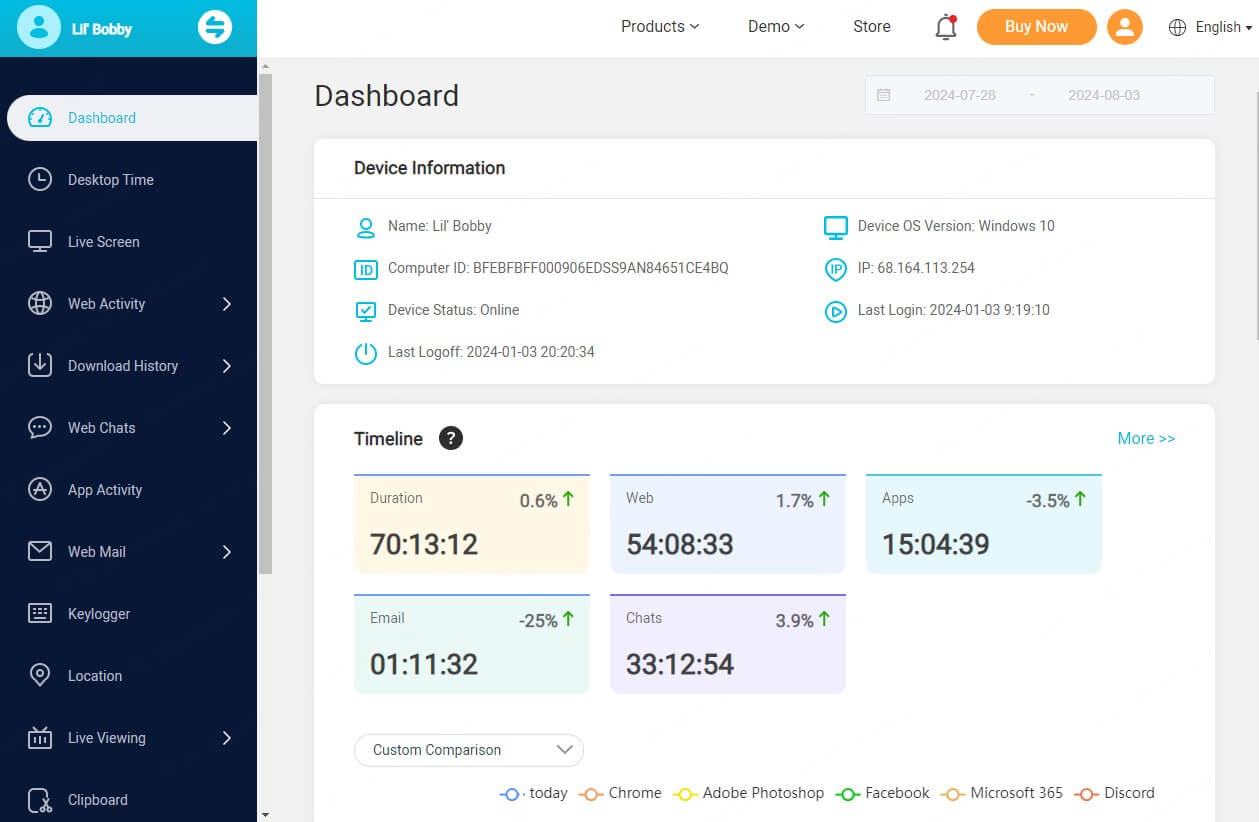ClevGuard Support: Monitor Devices with Others' Permission.
Today's dynamic work environment often blurs the boundaries of professionalism and personal time, leading many to explore moonlighting jobs meaning in a bid to meet their personal and professional goals.

This article delves into what is considered moonlighting in businesses and workplaces, different types of moonlighting, and the reasons why employees may choose to engage in it. It further explores if moonlighting is legal and outlines potential issues that could arise, offering effective strategies for managing moonlighting within your organization.
Table of Contents
What Is Considered Moonlighting in Businesses and Workplaces?
Moonlighting, in its simplest form, refers to an individual holding a second job in addition to their primary employment. This practice can vary widely, but it typically raises concerns if not openly disclosed to employers or if it creates a conflict of interest within the primary job's business environment. You might find that moonlighting isn't illegal; many employees opt for a secondary job to supplement their income or manage financial necessities.
Moonlighting often involves working a secondary job outside of standard business hours. For instance, an employee might work a regular 9-to-5 job and then engage in different work during the evenings to earn extra money. This is particularly common in sectors like health, education, and technology, where the demands and opportunities for additional work are abundant.
Common Types of Moonlighting
Understanding the various types of moonlighting can help you better manage your workforce and ensure compliance with company policies. Here's a breakdown of the common categories:
Blue moonlighting
Blue moonlighting occurs when employees find it challenging to balance multiple jobs. This type often leads to decreased productivity as individuals struggle to meet the demands of both their primary and secondary employment. It's crucial to recognize signs of overcommitment to prevent burnout and ensure optimal performance in their main role.
Quarter moonlighting
In quarter moonlighting, individuals take on part-time jobs alongside their primary employment. This arrangement typically involves working a few hours after their main job. It's a popular choice for those looking to supplement their income without significantly impacting their primary job responsibilities.
Half moonlighting
Half moonlighting is when employees dedicate nearly 50% of their free time to a secondary job. This type of moonlighting can be more demanding and may require careful balancing to avoid conflicts with the primary employment. It's essential for employers to monitor such arrangements to ensure that both jobs are managed effectively without compromising the employee's performance.
Full moonlighting
Full moonlighting involves engaging in two full-time jobs, where individuals might also initiate their own business ventures. This requires exceptional time management and often, a high level of energy and commitment. While it offers the highest income potential, it also carries significant risks of conflict of interest and performance issues in one or both jobs.

Each type of moonlighting presents unique challenges and opportunities. As an employer, it's your responsibility to understand these differences and create policies that allow employees to pursue additional work opportunities responsibly and transparently.
Reasons Employee Moonlight
Earn extra income
Many employees opt for moonlighting to supplement their primary income, especially when their main job doesn't cover all financial needs. Rising living costs, unexpected expenses, or the desire to improve their standard of living are common motivators. This is particularly true in high-cost areas where the basic salary may not be sufficient to meet all expenses, pushing employees to seek additional sources of income through part-time jobs or freelancing gigs.
Explore new opportunities
Moonlighting also serves as a platform for employees to access career opportunities that are not available in their primary jobs. If the current role does not align with their career goals or fails to offer growth opportunities, they might take up secondary employment to acquire new skills or gain experience in other fields. This not only enhances their employability but also broadens their professional horizon.
Concerns about job insecurity
Economic instability and job market fluctuations can instill a sense of insecurity regarding job continuity. Employees might engage in moonlighting as a precautionary measure to ensure they have a fallback option in case of job loss. This strategy provides a safety net, allowing them to maintain financial stability even during uncertain times.
Pursue personal interest
Many individuals engage in moonlighting to pursue personal interests or passion projects that their main job does not accommodate. Whether it's starting a side business, engaging in artistic endeavors, or volunteering, moonlighting provides an avenue for personal fulfillment and satisfaction that complements their primary employment.
Set up their own business
For those aspiring to entrepreneurship, moonlighting can be a stepping stone towards establishing their own business. It allows them to test the waters, build a customer base, and develop a business model while still having the financial security of a primary job. This dual approach helps mitigate the risks associated with starting a new venture and provides practical experience in managing a business.
By understanding these motivations, employers can better address the needs of their workforce and create policies that support healthy work-life integration and employee satisfaction.
Is Moonlighting Illegal? Potential Issues with Moonlighting
Moonlighting, while generally legal, can be subject to specific restrictions based on your employment contract or organizational policies. It's essential to thoroughly review your employment contract, as many employers incorporate clauses that restrict or regulate moonlighting. These measures aim to prevent conflicts of interest, protect confidential information, and maintain the company’s reputation. Always ensure you are aware of any stipulations that could affect your engagement in secondary employment.

Conflicts of interest
A critical aspect to consider is avoiding situations where your secondary job might create a conflict of interest with your primary employer. This could involve working for a direct competitor or engaging in activities that could undermine your role at your primary job. It’s crucial to navigate these waters carefully to maintain trust and integrity in your professional relationships.
Legal and contractual implications
Engaging in moonlighting that violates your employment contract can lead to severe consequences, including termination or legal action from your employer. Be particularly mindful of clauses that explicitly prohibit secondary employment or require prior approval from your employer before taking on additional work.
Labor law compliance
Ensure compliance with labor laws in your jurisdiction, which might include adhering to maximum working hours and ensuring proper compensation for overtime. Some regions have specific regulations governing moonlighting, making it imperative to understand and adhere to these laws to avoid legal complications.
Address unlawful activities
It is imperative to steer clear of any illegal or unethical activities while moonlighting. Engaging in such actions is not only illegal but could also severely damage your professional reputation and lead to legal repercussions.
Employer’s perspective on moonlighting
Employers may establish policies requiring you to disclose any outside employment. This disclosure helps employers assess potential conflicts of interest and ensure that moonlighting does not compromise business interests. In some cases, you may be asked to cease external employment if it presents a significant conflict or affects your job performance adversely.
Employers are also justified in prohibiting the use of company resources or time to perform tasks related to outside employment. This includes not using company equipment or working on secondary jobs during business hours.
By understanding these potential issues and navigating them wisely, you can engage in moonlighting responsibly, ensuring it adds value to your life without risking your primary employment or legal standing.
Effective Strategies to Manage Moonlighting
Establish clear policies
It's vital to have a well-defined moonlighting policy that addresses the needs and concerns of both the organization and its employees. This policy should clearly state the conditions under which employees can engage in secondary employment, including the need for transparency and the prioritization of their primary job. Emphasize the importance of avoiding conflicts of interest and ensure that all employees understand the rules and provisions laid out in the policy.
Encourage employee engagement
Open communication is crucial in managing moonlighting effectively. Encourage your employees to discuss their secondary employment plans with their managers. This can help in understanding their needs and exploring whether the primary job can offer them additional hours or projects instead. Regular engagement can also lead to identifying and providing necessary support through resources like Employee Assistance Programs, which may offer financial counseling or career advancement opportunities.
MoniVisor: Implement employee monitoring software
Utilizing computer monitoring tracker program like MoniVisor can help in monitoring the work activities of employees to ensure they are not compromising their responsibilities in the primary job. These tools can track screen time on a laptop, monitor productivity, and help in maintaining a balance between multiple jobs. It's a practical approach to verify that secondary employment does not negatively impact the employee's performance or the organization’s operations.

Offer incentives and rewards
To discourage employees from needing to moonlight, consider enhancing the benefits provided within your primary employment. This could include competitive salaries, performance bonuses, or recognition programs. Such incentives can make the primary job more rewarding and reduce the need for employees to seek additional employment.
Promote a healthy work-life balance
Finally, fostering an environment that values work-life balance can prevent burnout and reduce the appeal of moonlighting. Encourage employees to manage their workload effectively and provide support for personal development and leisure activities. This not only enhances job satisfaction but also promotes loyalty and productivity in the workplace.
Conclusion
This post navigates the complexities of moonlighting with a thoughtful and informed approach, employers and employees alike can synergize their efforts towards mutual satisfaction and success, reinforcing the fundamental truth that when work becomes a shared journey of growth, the entire workplace thrives.








